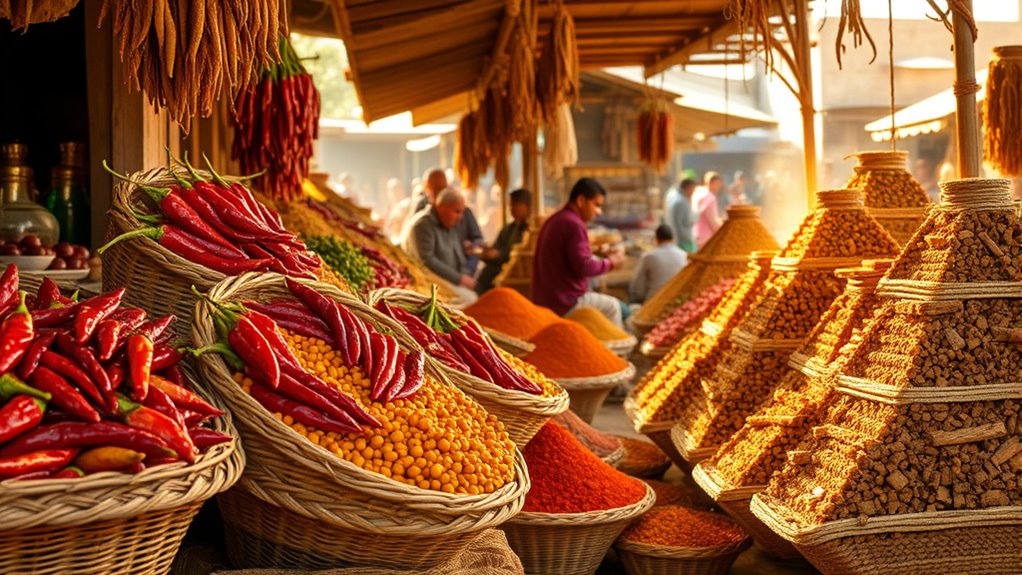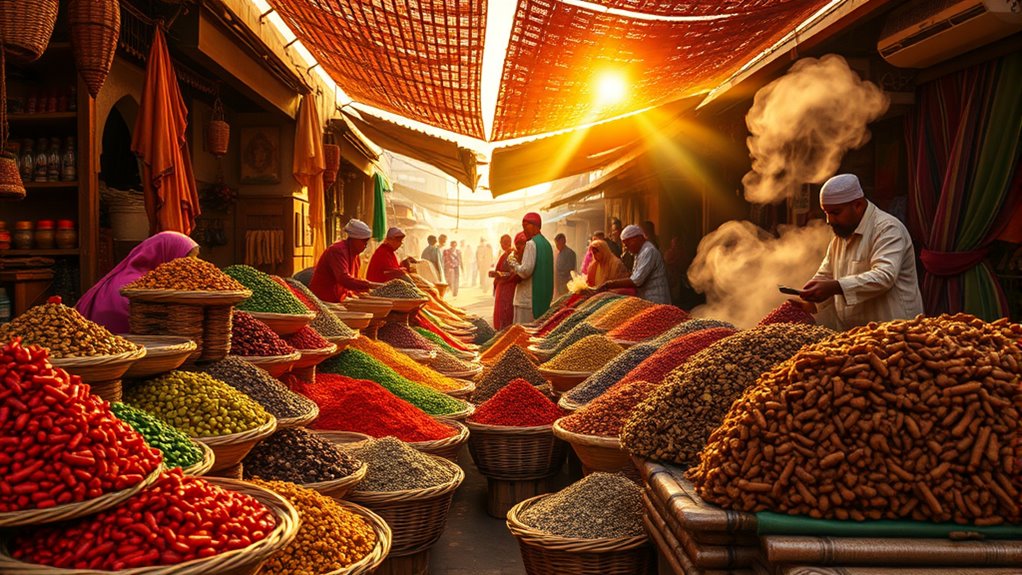The spice routes have connected civilizations for over 4,000 years, starting from merchants in the Middle East exchanging cinnamon, cassia, and pepper. You’ll find that these routes expanded from overland paths to complex maritime networks linking Africa, Asia, and Europe. This trade wasn’t just about spices; it also spread culture, technology, and wealth. To uncover how these ancient pathways shaped our world and still influence today’s trade, keep exploring this fascinating history.
Key Takeaways
- The spice trade began over 4,000 years ago in the Middle East, connecting regions through complex overland and maritime routes.
- Maritime networks by the first century CE linked Europe, Africa, India, and Asia, facilitating extensive cultural and economic exchanges.
- European powers, such as Venice, Portugal, and the Netherlands, expanded routes during the Age of Exploration, establishing global trade empires.
- Control over spice routes influenced historical conflicts, politics, and the rise of colonial empires across Asia, Africa, and Europe.
- The legacy of spice trade routes persists today, shaping modern global commerce, cultural ties, and culinary traditions worldwide.

Have you ever wondered how spices from distant lands shaped the course of history? It all started over 4,000 years ago in the Middle East, where the spice trade first emerged. Merchants began exchanging aromatic treasures like cinnamon from Sri Lanka and cassia from China, traveling along what became known as the Spice Routes. By 2000 BC, these spices moved through intricate networks, overland and maritime, connecting distant regions. Around 1000 BCE, cinnamon and pepper from India and Indonesia reached Egypt, fueling demand and sparking curiosity about the faraway lands that produced them. Early spice traders often kept the origins of their goods secret, creating a sense of exclusivity that drove up their value. Their journeys were perilous but essential, as spices traveled across deserts, seas, and mountains, linking civilizations in a web of commerce. These routes also facilitated the exchange of cultural ideas and technological innovations, further enriching the interconnectedness of ancient societies. Additionally, the trade routes played a crucial role in spreading not only spices but also culinary techniques and medicinal knowledge across regions. The economic impact of the spice trade was profound, influencing the development of markets and currencies in various civilizations.
As time progressed, these routes became more complex and far-reaching. By the first century CE, a sophisticated maritime network connected Rome, the Mediterranean, Africa, India, Indonesia, and China. India emerged as a central hub, with Indian dhows and Chinese junks navigating vast ocean distances—over 9,000 miles of sea routes—linking East and West. These routes weren’t just for spices; merchants also traded ivory, silk, and gemstones, turning these networks into bustling corridors of wealth and culture. Control over these routes became a prize for powerful empires. After Rome’s fall around 250 CE, the Byzantines and later European powers took the helm. Arabs and Muslims expanded the spice trade across the Middle East and Southeast Asia, establishing dominance. Venice and Genoa, thriving city-states, monopolized European access to Asian spices from the 11th to 15th centuries, even fighting wars during the Crusades to secure their trade interests. By 1453, the Ottomans controlled key overland routes, further shaping the trade landscape. This growth in trade also contributed to the development of maritime navigation techniques, which allowed explorers to venture further across uncharted waters.
The Age of Exploration revolutionized this network. Vasco da Gama’s discovery of the Cape of Good Hope route in 1498 opened direct pathways from Europe to India, prompting Portugal to establish a spice empire centered in Goa. Meanwhile, Spain launched the Manila Galleon route across the Pacific, linking Asia and the Americas. The Dutch developed their own ocean routes, competing fiercely for control. Spices like black pepper, cloves, and nutmeg became highly profitable because of their small size and ease of transport, fueling European ambitions, wars, and colonization. These routes weren’t just about commerce—they facilitated cultural exchanges, spreading ideas, foods, and technologies around the world. The spice trade drove globalization and shifted global power balances, leaving a legacy that persists today. Modern “Maritime Silk Roads” and UNESCO studies recognize the lasting importance of these routes. The search for spices motivated explorers’ daring voyages and helped shape today’s global economy, with spices still enriching our cuisines and economies centuries later.
Frequently Asked Questions
How Did Spices Influence Ancient Global Trade Networks?
You see, spices greatly influenced ancient global trade networks by being highly valuable and easy to transport. They connected diverse civilizations, encouraging cultural exchanges and technological advances. Control over spice sources and routes made port cities wealthy and powerful, often leading to conflicts. As traders sought new routes, they expanded trade networks, shaping history, economy, and exploration, ultimately laying the foundation for the interconnected world we are familiar with today.
What Were the Cultural Impacts of Spice Exchanges?
You see, the spice exchanges had a huge cultural impact. They spread religions like Buddhism, Islam, and Christianity, shaping beliefs across regions. You also notice influences in art and architecture, blending styles from India, China, and the Islamic world. Additionally, the exchange of spices fostered linguistic diversity and culinary innovations. These interactions created a rich tapestry of cultural connections, leaving a lasting legacy on societies worldwide.
Which Modern Countries Were Key Spice Trade Hubs?
You might notice that modern countries like India, Sri Lanka, Indonesia, Oman, Yemen, Italy, and Spain played key roles in the spice trade. These nations served as crucial hubs for cultivation, collection, and distribution of spices. India and Sri Lanka remain important today, while Middle Eastern and European ports historically connected Asian producers to global markets. Their strategic locations and maritime routes made them essential centers for spice commerce.
How Did Spice Routes Shape Culinary Traditions Worldwide?
Imagine a grand tapestry, with vibrant threads crossing continents—spice routes wove these connections, shaping global cuisine. They introduced flavors like cinnamon and saffron, transforming dishes across regions. As you explore, you see how spices fueled cultural exchanges, blending techniques and ingredients. Today’s diverse dishes reflect these ancient trade paths, showing how spice routes turned local flavors into a global culinary mosaic, enriching your palate with stories of history.
What Technological Advancements Facilitated Spice Trade Routes?
You see, technological advancements greatly facilitated spice trade routes. You’d rely on improved sailing techniques, sturdy ships, and monsoon wind knowledge to travel farther and faster. Navigational tools like the compass made journeys more precise, while ship design increased cargo capacity. Modern innovations like refrigeration, air transport, and containerization have further expanded spice distribution. Better communication, digital platforms, and blockchain also streamline trade, making the entire process more efficient and secure.
Conclusion
As you trace the spice routes, it’s incredible to realize that a simple pinch of cinnamon or a dash of pepper once connected distant lands in ways you never imagined. Sometimes, it’s strange how a chance encounter or a wandering trader could ignite a global craving, shaping history in subtle, unexpected ways. So next time you sprinkle spices into your meal, remember—you’re part of a centuries-old story woven through chance, commerce, and curiosity.









